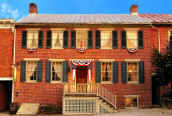Media
Private Historical Sites are More Popular

Unfortunately, the ability of non profit groups, private philanthropy and individual entrepreneurship have to preserve our historic sites and natural resources is largely overlooked.
The perception that privately run historic sites or parks are of lesser quality is entirely unfounded and exposes what little people really know about sites of public interest.
The Shriver House Museum and General Lee’s Headquarters Museum in Gettysburg are entirely privately owned and operated and are the only museums in Pennsylvania to make the History Channel’s “10 Must Visit U.S. Historical Sites.” In fact, over half of the attractions listed are either private-public partnerships or privately owned and operated.
Countless examples exist of the private sector stepping in to create and save historical places, including Muir Woods National Monument. This redwood forest exists today because of businessman and philanthropist, William Kent, who upon being threatened with eminent domain donated his land to the Federal Government-asking it be declared a national monument dedicated to his favorite naturalist, John Muir.
Sadly, many of our government managed natural and historical treasures, like Muir Woods National Monument, are in danger of closing. This can be prevented by allowing private individuals and companies to lease or buy these places.
The moral of the story is those sites that taxpayers are forced to support are often inferior to those run by the private sector. Citizens should be able to choose which museums and historical sites to patronize.